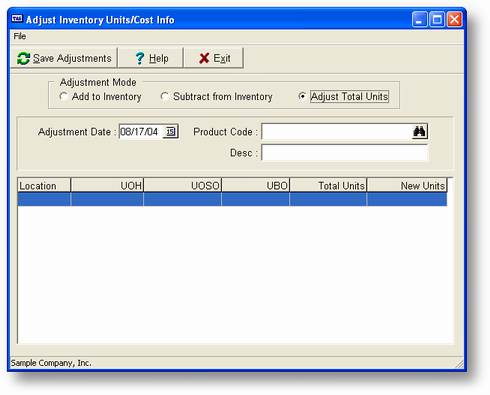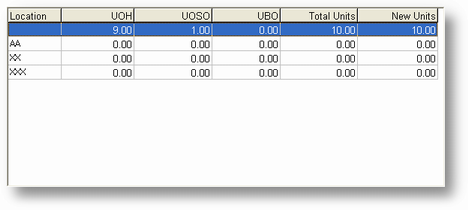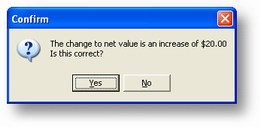Purpose of Program
Use this program to adjust the units on hand or cost/unit for an item and automatically update G/L Asset and Expense accounts with these adjustments. Normally, you would run this program after taking a physical inventory count, but you can make adjustments at any time. One typical use of the program is to decrease the amounts on hand due to loss, theft, or spoilage.
![]() You may not adjust the total units or value for a Non-inventory (N) type product.
You may not adjust the total units or value for a Non-inventory (N) type product.
The fields you will use to make the adjustments are illustrated below.

Field Explanations

Adjustment Mode
There are three entry modes supported by this program. Add to Inventory. Subtract from inventory. Adjust Total Units. The Default is Adjust to inventory. If you click on the Add to inventory mode when you enter new units you will be ading to what the computer has on file. If you have the Subtract from inventory mode on you will be subtracting from what the computer has on files and if you have the adjust total units mode on. You will be replacing what the computer says in are in inventory.
Adjustment Date
The value to be used as the posting date for this transaction.
Product Code
The code of the item being adjusted. You can use standard record search keys to locate the inventory item.
Description
Default description of the inventory item. This is defined in the inventory record.
Location
Each location for this item is listed as a separate record.
UOH
Units on hand for this item and location.
UOSO
Units reserved on a sales order but not yet invoiced.
UBO
Units on back order.
Tot Units
The current total of units on hand + units on S/O for each location record. This is the total number of units that, according to the inventory records, you should expect to find when you take a physical count.
New Units (location record)
When the record for this inventory item location is first displayed, this is the same number as Total Units. If you change the number of units for this location record then this value will reflect that change.

New Units (popup screen displayed above)
This is where you'll enter the new units value to change the location record total.
New Avg Cost
You can change the average cost for the location here. This defaults to the Original Avg Cost.
Orig Avg Cost
The current average cost for the location. This may change when you move from one location to another depending on the value for that location.
General Program Operation
Enter the Adjustment Date. This will default to today's date.
Then find the appropriate product. Enter the full product code and press ENTER or use the standard search keys. You can use the F2 function key as well as the standard record search keys to look at the available product codes.

The product description and location records will be displayed as above.
Move the selection bar to the appropriate location record. Press the ENTER key to move the cursor to the entry fields.
The popup entry screen below will be displayed. Enter the New Units and New Avg Cost amounts for that location.

After you have made your changes to the New Cost per Unit and/or New Units, the program will display a dialog box similar to the one below that shows the calculated change in total value and allows you to confirm if this is correct.

If you are moving units from one location to another, locations that have different account codes or departments for the inventory item will automatically adjust the appropriate G/L Asset accounts for inventory value.
When you click the Adjust button on the main screen, the inventory record is updated for units on hand, cost, and value, the location file is updated for units on hand, and the transaction posts to the Other Journal and the General Ledger. The program will clear the screen and return to the Product Code field when it is finished. If you exit the main screen non of your changes will be saved.
![]() The transaction made to the General Ledger is a debit to the G/L COGS account (i.e., increase costs) and a credit to the G/L Asset account (i.e., decrease value) for this item if the total value has decreased. If the total value has increased, the G/L Asset account will be debited (increased) and the G/L COGS account will be credited (decreased).
The transaction made to the General Ledger is a debit to the G/L COGS account (i.e., increase costs) and a credit to the G/L Asset account (i.e., decrease value) for this item if the total value has decreased. If the total value has increased, the G/L Asset account will be debited (increased) and the G/L COGS account will be credited (decreased).
Page url: http://www.cassoftware.com.com/adv7docs/index.html?ic_g_adjustlevelstophysic.htm